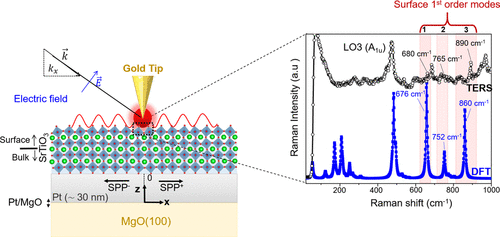当前位置:
X-MOL 学术
›
J. Phys. Chem. C
›
论文详情
Our official English website, www.x-mol.net, welcomes your
feedback! (Note: you will need to create a separate account there.)
Symmetry-Forbidden-Mode Detection in SrTiO3 Nanoislands with Tip-Enhanced Raman Spectroscopy
The Journal of Physical Chemistry C ( IF 3.3 ) Pub Date : 2021-03-11 , DOI: 10.1021/acs.jpcc.0c10938 Azza Hadj Youssef 1 , Jiawei Zhang 1 , Alborz Ehteshami 1 , Gitanjali Kolhatkar 2 , Chahinez Dab 3 , Dorothée Berthomieu 4 , Alexandre Merlen 5 , François Légaré 1 , Andreas Ruediger 1
The Journal of Physical Chemistry C ( IF 3.3 ) Pub Date : 2021-03-11 , DOI: 10.1021/acs.jpcc.0c10938 Azza Hadj Youssef 1 , Jiawei Zhang 1 , Alborz Ehteshami 1 , Gitanjali Kolhatkar 2 , Chahinez Dab 3 , Dorothée Berthomieu 4 , Alexandre Merlen 5 , François Légaré 1 , Andreas Ruediger 1
Affiliation

|
Among the techniques to reveal the chemistry, structure, and dynamics of surfaces, tip-enhanced Raman spectroscopy (TERS) occupies a unique position for the investigation of nonmetallic nanomaterials: it provides a wealth of information of Raman spectroscopy even under ambient conditions with the opportunity for spatial resolution below the diffraction limit. The high sensitivity of the optical near field to surfaces has been exploited on self-assembled monolayers on multiple occasions, and yet, the potential for the investigation of crystalline surfaces remains to be unfolded. Using strontium titanate (SrTiO3) as a model system, we demonstrate that TERS does not only provide insight into surface symmetries but also activates otherwise symmetry-forbidden modes. The bulk phase of strontium titanate is Raman-inactive, and the optical far field therefore does not provide any first-order Raman signature: as a consequence, any peak in TERS configuration originates from the optical near field, confined to a few nanometers at the apex of the tip. We observe first-order Raman peaks interpreted as TO2, TO4, and LO4 phonon modes and the strong field enhancement of both infrared-active LO3 and Raman surface modes in agreement with density functional theory (DFT) calculations. The intensity enhancement of the surface modes shows the sensitivity of TERS to monitor surface relaxation effects associated with structural phase transformations into, e.g., a polar phase, and to detect surface reconstructions that are known to be crucial for photocatalytic activity.
中文翻译:

尖端增强拉曼光谱技术在SrTiO 3纳米岛中的对称禁止模式检测
在揭示表面化学,结构和动力学的技术中,尖端增强拉曼光谱(TERS)在研究非金属纳米材料方面占有独特的位置:即使有机会在环境条件下,它也提供了丰富的拉曼光谱信息低于衍射极限的空间分辨率。光学近场对表面的高灵敏度已经在多种情况下在自组装单分子膜上得到了利用,但是,研究晶体表面的潜力仍有待开发。使用钛酸锶(SrTiO 3)作为模型系统,我们证明TERS不仅可以洞悉表面对称性,还可以激活其他方式禁止的对称模式。钛酸锶的本体相是无拉曼活性的,因此光学远场不提供任何一阶拉曼特征:结果,TERS构型的任何峰都来自光学近场,并限制在纳米处。尖端的顶点。我们观察到被解释为TO2,TO4和LO4声子模式的一阶拉曼峰,以及与密度泛函理论(DFT)计算一致的红外活性LO3和拉曼表面模式的强场增强。表面模态的强度增强表明TERS监视与结构相转变为极性相相关的表面弛豫效应的敏感性,
更新日期:2021-03-25
中文翻译:

尖端增强拉曼光谱技术在SrTiO 3纳米岛中的对称禁止模式检测
在揭示表面化学,结构和动力学的技术中,尖端增强拉曼光谱(TERS)在研究非金属纳米材料方面占有独特的位置:即使有机会在环境条件下,它也提供了丰富的拉曼光谱信息低于衍射极限的空间分辨率。光学近场对表面的高灵敏度已经在多种情况下在自组装单分子膜上得到了利用,但是,研究晶体表面的潜力仍有待开发。使用钛酸锶(SrTiO 3)作为模型系统,我们证明TERS不仅可以洞悉表面对称性,还可以激活其他方式禁止的对称模式。钛酸锶的本体相是无拉曼活性的,因此光学远场不提供任何一阶拉曼特征:结果,TERS构型的任何峰都来自光学近场,并限制在纳米处。尖端的顶点。我们观察到被解释为TO2,TO4和LO4声子模式的一阶拉曼峰,以及与密度泛函理论(DFT)计算一致的红外活性LO3和拉曼表面模式的强场增强。表面模态的强度增强表明TERS监视与结构相转变为极性相相关的表面弛豫效应的敏感性,


















































 京公网安备 11010802027423号
京公网安备 11010802027423号